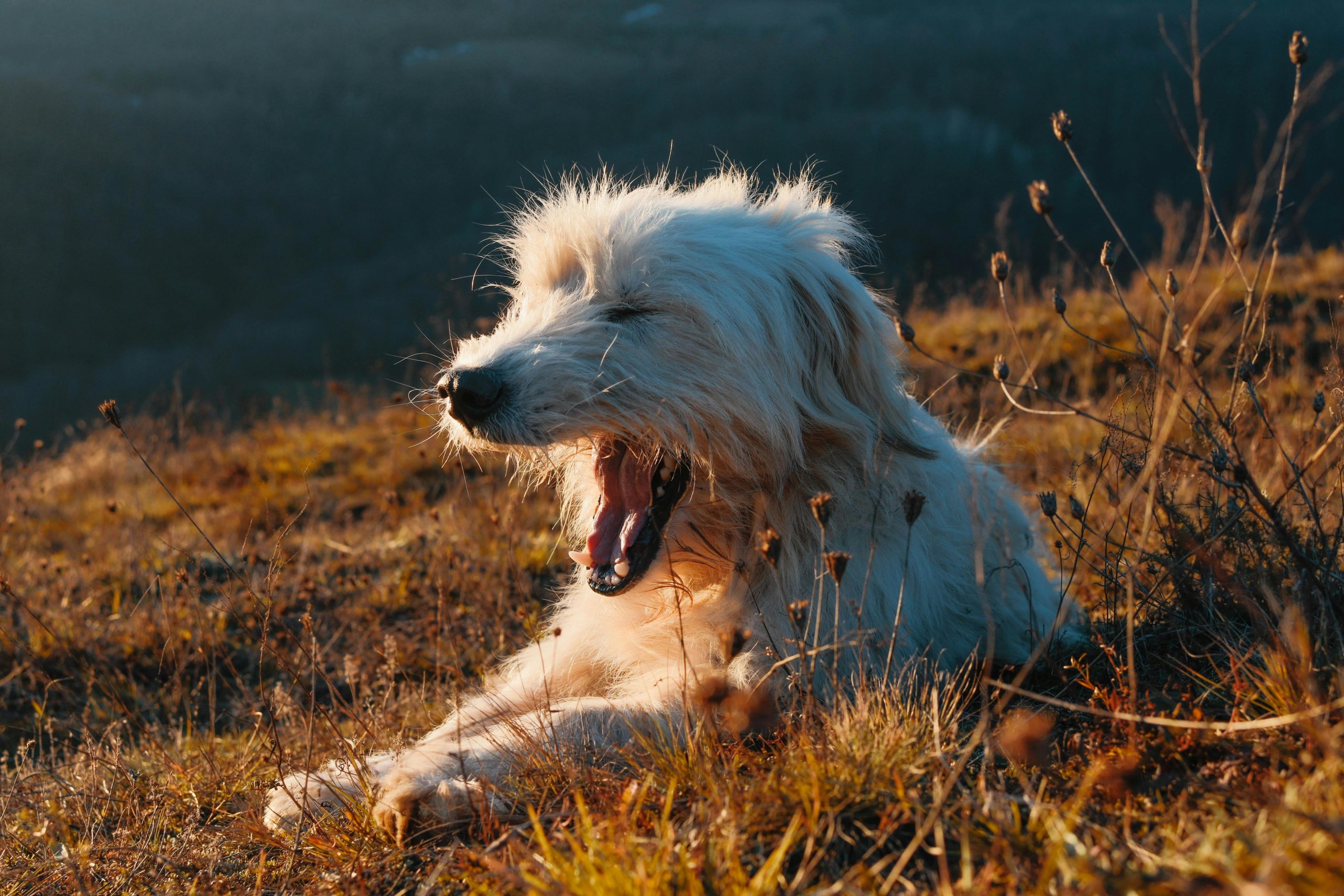
Disclaimer: Pets For Seniors. This site provides pets content for informational purposes only.
You’ve probably noticed your dog yawning or stretching, often multiple times a day. While these behaviors are entirely normal, they can also leave you wondering: what do they mean? Are they just being relaxed, or could there be something more to it? Let’s explore the reasons why dogs yawn and stretch, and when these actions might indicate something worth checking out.
Is Yawning and Stretching Normal for Dogs?
Yes, yawning and stretching are perfectly normal behaviors for dogs. Like humans, dogs stretch and yawn as part of their daily routines. While these actions often reflect a dog’s emotional state or physical comfort, they can also indicate stress, pain, or other health issues. Understanding when these behaviors are part of their normal routine and when they may be signs of something else can help ensure their health and well-being.
What Does It Mean When Your Dog Yawns?
Yawning is a common behavior in dogs, and it can happen for a variety of reasons. Here are some of the most common reasons why dogs yawn:
1. Relaxation and Comfort
Dogs often yawn when they’re feeling relaxed and at ease. Much like how humans yawn when they wake up or settle down after a long day, dogs may yawn when they’re comfortable, either after waking up from a nap or during a restful period. If your dog is yawning while lounging or resting, it likely means they’re simply unwinding.
2. Communication: A Sign of Calmness
Yawning can also serve as a non-verbal communication signal between dogs and humans. In some situations, dogs yawn to show they’re not feeling threatened. This is especially true when interacting with other dogs or new people. It’s a peaceful gesture that indicates your dog is calm and not trying to display aggression.
3. Stress or Anxiety
On the flip side, yawning can also be a sign of stress or anxiety, and in this case, it may be considered a form of displacement behavior in dogs. If your dog is in an unfamiliar situation, such as at the vet or around loud noises, they may yawn more often as a way of coping with stress. Yawning in this case can be a self-soothing behavior, helping your dog calm their nerves.
4. Health Issues: When to Be Concerned
While yawning is typically harmless, excessive yawning can sometimes indicate discomfort, pain, or even illness. If your dog is yawning more than usual and showing signs of fatigue, loss of appetite, or changes in behavior, it’s a good idea to schedule a vet visit. Conditions like nausea, dental issues, or neurological concerns could be contributing to the increase in yawning.
Why Does My Dog Keep Stretching?
Stretching is another common and important behavior in dogs, often linked to physical well-being. Let’s break down the different reasons why your dog might stretch frequently:
1. Morning Stretching: A Wake-Up Call
Much like us, dogs often stretch when they wake up in the morning or after a nap. Stretching helps get their muscles moving and prepares their bodies for the day. It’s a sign that your dog’s body is waking up from rest and is ready for activity.
2. Stretching as a Sign of Comfort
Stretching can also be a sign that your dog is feeling comfortable and content. After resting or napping for a while, your dog may stretch out their body to relieve tension or to get more comfortable. This is completely normal and is part of their natural routine.
3. Stretching and Playfulness
Some dogs stretch as part of their “play bow,” which is a signal that they’re ready to play. This kind of stretching is usually accompanied by a wagging tail or an excited stance. If your dog stretches in this playful way, it’s likely an invitation for fun and interaction.
4. Pain or Discomfort: A Cause for Concern
While stretching is usually a healthy behavior, it can sometimes be linked to pain or discomfort. If your dog is stretching frequently but also showing signs of reluctance to move, limping, or appears stiff, it might indicate joint pain or arthritis. Older dogs, in particular, may experience muscle stiffness, which could lead to more frequent stretching. If this is the case, it’s important to have your dog checked by a vet to ensure they’re not dealing with a painful condition.
5. Muscle Stiffness or Injury
Excessive stretching might also suggest that your dog is trying to relieve muscle stiffness or tension. If you’ve been taking your dog on longer walks or engaging in more active play, they may stretch to soothe sore muscles. However, if stretching becomes excessive or seems to be paired with signs of injury (such as limping), it’s best to consult a vet.
How Can You Help Your Dog if They Yawn and Stretch Frequently?
If you’ve noticed your dog yawning and stretching more often than usual, you may be wondering how to help them. Here are a few things you can do to support your dog’s health:
1. Create a Comfortable Environment
Ensure that your dog has a comfortable and relaxing space to rest. This includes providing a cozy bed or resting area that supports their body, especially as they age. Orthopedic beds are great for dogs with joint discomfort, helping them sleep more comfortably and reduce stiffness.
2. Reduce Stress and Anxiety
If your dog’s yawning is linked to stress or anxiety, try to minimize the sources of stress in their environment. This could mean reducing noise levels, providing a quiet retreat for them, or avoiding sudden changes in their routine. If your dog is stressed during car rides or vet visits, using calming aids like pheromone sprays or anxiety wraps can help them feel more at ease.
3. Encourage Gentle Exercise
Keeping your dog active is important for their overall health, but be mindful of their age and physical condition. Senior dogs may need gentler, low-impact exercise to keep their muscles and joints strong. Short walks, gentle play sessions, or swimming can be great ways to keep them moving without overtaxing their body.
4. Regular Vet Check-Ups
If your dog’s stretching or yawning seems excessive, especially if accompanied by signs of pain or discomfort, make sure they see the vet. Regular check-ups are essential to monitor for any underlying health issues, such as arthritis, hip dysplasia, or other conditions that might be causing pain or stiffness.
5. Pain Management for Older Dogs
For older dogs, joint pain and stiffness can become more prevalent. If you suspect your dog is experiencing discomfort, talk to your vet about pain management options, including joint supplements, medications, or physical therapy. These treatments can help alleviate pain and improve your dog’s mobility.
Why Does My Dog Keep Yawning and Stretching—and Should I Be Concerned?
While yawning and stretching are typically harmless and part of a dog’s normal routine, there are times when they may signal something more serious. Consider these signs that suggest it’s time to consult your veterinarian:
-
Excessive yawning – If your dog is yawning frequently and also appears tired, withdrawn, or disinterested in activities, it could be a sign of stress, discomfort, or an underlying health issue.
-
Repeated stretching paired with stiffness – When stretching is accompanied by signs of difficulty moving, limping, or hesitation to get up, it may point to joint pain, muscle strain, or arthritis—especially in older dogs.
-
Noticeable behavioral changes – If yawning or stretching coincides with appetite loss, weight fluctuations, or increased irritability, it may indicate pain or illness requiring medical attention.
Being aware of the context and frequency of these behaviors can help you spot potential issues early and keep your dog feeling their best.
Final Thoughts
Yawning and stretching are natural and healthy behaviors in dogs, often linked to relaxation, comfort, and even playfulness. However, if these actions seem excessive or are accompanied by other signs of distress or discomfort, it may be worth exploring further. Regular vet visits, a comfortable environment, and appropriate exercise routines can help keep your dog happy, healthy, and pain-free, especially as they age. If you’re ever in doubt, your veterinarian is the best resource to help address any concerns about your dog’s health and well-being.

